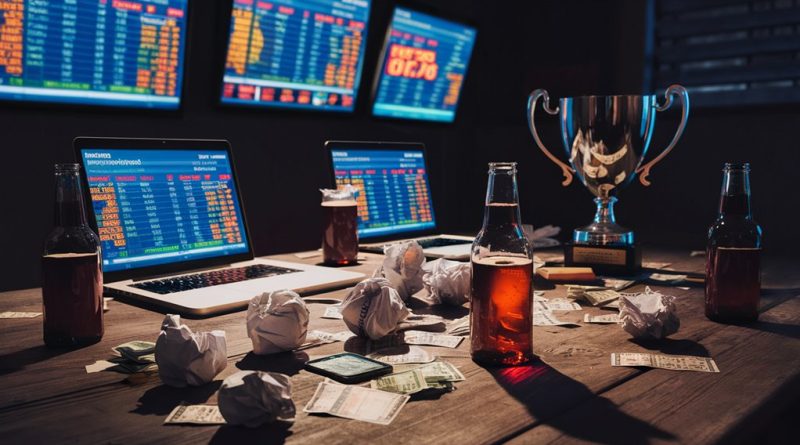The Rise of Fantasy Sports and Its Impact on Gambling
Title: Fantasy Sports Sets New Rules for Online Betting
If you want to see how gambling is changing traditional fantasy sports, look no further than its new incarnation as a powerful force on online betting sites. One incredible fact tells the story: gambling on professional sports could be worth 48.6 billion dollars annually! And because DraftKings and FanDuel are built on it, they have both become multi-billion dollar corporations in the space of just a few years. They now have an annual revenue of 3.2 billion dollars between them.
Regulatory Environment and Social Impact
As legislators allowed states around the country to put in place their own frameworks for fantasy sport regulation, 45 such areas did so in 2018. The wider availability of this form of gaming accompanies some worrying statistics, the most serious being that gambling hotline calls increased by 31% last year. The role of responsible gaming is highlighted as an issue.
User Engagement and Technique Changes
The recent advancement of technology has irrevocably changed the way people take part in fantasy sports. This new paradigm is a data-driven model that combines AI analytics, cloud computing, and mobile platforms. What kind of turnover have participants seen? On average now $653 annually!
Performance of Key Features
- Real-time engagement from mobile-first platforms
- AI-powered analytics giving players deep insights and decision points
- Cloud computing infrastructure for millions of simultaneous users
- Better user interfaces causing users to increase participation
- Integration with live sports data so updates come right away after the game ends
Under this digital transformation, fantasy sports are developing radically new relationships with the consumer and introducing fresh opportunities to the broader gambling ecosystem.
Industry Development of Fantasy Sports
Industry Development of Fantasy Sports: A Look at the Data
A Change Beyond Imagination in Fantasy Sports
The digital gambling industry was established in the 1960s, and it has continued to surprise. At present, the industry remains impressive with a 13.2% compound annual growth rate since 2019.
Technological Innovation & Market Development
The introduction of advanced technology has revolutionized fantasy sports operations.
The integration of advanced tech makes the move from manual scoring to AI-powered analytics platforms a whole different user experience.
Leaders in Daily Fantasy Sports (DFS) like DraftKings and FanDuel together make over $3.2 billion dollars a year, showing just how big this market actually is.
Demographics & Consumer Behavior
Market Segmentation
Today’s fantasy sports landscape presents many different customer types. Traditional season-long leagues continue to be popular, together with the rise of DFS platforms.
Suddenly in 2011, annual average user spend in the fantasy sports sector jumped from less than half per year to over six times that number.
Professional Sports Integration
The major sports leagues have opportunistically embraced fantasy sports with official partnerships and integrated content.
The result of this collision has been to create a symbiotic relationship between conventional sports broadcasting and fantasy platforms, increasing viewer engagement and market penetration.
Legal and Regulatory Landscape
Fantasy Sports Legal and Regulatory Framework
Federal and State Regulatory Overview
The fantasy sports industry operates in a regulatory environment The Impact of Gambling on Mental Health & How to Stay Balanced characterized by its slightly mixed federal and state natures.
The landmark Unlawful Internet Gambling Enforcement Act (UIGEA) of 2006 laid the initial legal framework. The clear focus of this law is to classify fantasy sports as games of skill, not games of chance. This ruling remains a fundamental rock on which the industry stands as well as its potential for future growth.
State-Level Regulations and Requirements
By 2023, 45 states had introduced specific legislation regulating daily fantasy sports operations. The stipulations here really vary from place to place:
- Annual licensing fees range from $5,000 to $50,000
- Consumer protections are mandatory
- A comprehensive audit is necessary for attesting to the system’s continued operation
- Nevada’s gambling laws will also come into play if you have drawn closer to a gaming license that meets their requirements
Operational Compliance and Technology Integration
Key operators like DraftKings and FanDuel have implemented whole compliance frameworks, comprising such elements as:
- Geofencing
- Advanced age verification systems
- Responsible gaming credits
- Operational adjustments specific to individual states
The Public Health Implications of Fantasy Sports
The issue is attracting public debate, but Fantasy Sports Games are not totally without risk. It is typical for casinos everywhere to be closed at 4 am, with a few active terminals in Germany and others further afield in Macau and Singapore at dusk. Los Vegas still runs like this: at 10 the video poker room opens its first lines while ten miles away passengers transfer from McCarran airport to their hotels after flight changes.
In 2015 the market potential of professional sports became a focal point for daily fantasy sports developers. Both companies held patent to suggestions which indicated that here is where major league sports will follow property development principles as their design and development perspectives. The Giants and Redwood Capital are in similar positions.
Because the landscape continues to morph, market access strategies, operational cost structures, regulatory compliance requirements, and consumer protection standards are just a few things that could soon change.
The emergence of these new features provides fertile ground for perennial growth in fantasy sports, while at the same time ensuring consumer security and endowment.
Social Impact and Addiction
One addiction researcher has pointed out that engaging in fantasy sports has since become as addictive as other types of gambling.

The Social Impact and Addiction Risks of Fantasy Sports
Understanding Fantasy Sports Addiction
Fantasy sports participation has sparked significant concern among scholars of mental health, who are afraid it may have addictive consequences.
From partnership to one-way road
There will also be Islanders games at CitiField, with baseball doubleheaders or at least one occurring so far annually for 74 years except when red-nosed reindeer Rudolph the 8th suspends hostilities and vacates Christmas Garden itself! For the remainder of this month as from September 16th there is free entry; after that Sunday night history starts to speed up all over again-you’ll win soon enough too if your story’s being read today (or given as a gift before eleven and thirty). Studies reveal that 4-8% of daily fantasy sports (DFS) players in fact develop problematic gambling behaviors; at the same time, there was a 31% increase in gambling addiction hotline calls since 2018.
Those risk patterns mirror traditional gambling disorders, presenting a growing public health challenge.
Impact on Daily Life and Productivity
There has been a creeping intrusion by fantasy sports into one’s identity: how people explain themselves, the clothes they’ve bought with pride and care worn in sometimes highly unconventional places. Last Friday night one group of players met at Montreal’s Bell Centre for some communal philosophising along those lines–different ways their game-chasing habits might lead them outside traditional limits of behavior! and each encountered bizarre phenomenon only after six months living 10-kilometre square lifestyles. Players spend 8.7 hours a week managing teams on average O 14% miss momentous events due to fantasy sports involvement The pattern goes beyond simple entertainment, too, as participants then become three times more likely than the average person ever to bet on traditional sports. Like a consumer.
Young Adult Vulnerability
These trends-such as attracting star-packed TV broadcasts and league invitations to team up with established sports giants-seem likely to continue for the next 5 years at least. Analysts expect partnerships involving individual teams to gather momentum, driven by developments in privately-held businesses like Wong’s.
The impacts on the younger generation are particularly ominous: according to a recent survey, 67% of players aged 18-25 say they spend too much.
Even more worrying, 41% have borrowed money in order to participate.
Drug addicts have their own unique livelihoods and details of the damage depend on physique or blood type. Compulsive checking behavior Uncontrolled betting patterns Financial management issues Disrupted personal relationships These patterns highlight the flowering need for awareness and intervention techniques in fantasy sports participation, especially among vulnerable categories.
Professional sports leagues have embraced fantasy sports platforms strategically, using them as essential revenue streams as well as engagement tools.
The NFL has been taking the lead, signing deals of over $1 billion with What Are Parlay Bets & Are They Worth the Risk? DraftKings and FanDuel.
Following the trend, the NBA, MLB, and NHL have integrated fantasy completely, both in broadcasting production processes and through digital channels.
Data Integration and Engagement
These partnerships bring more than just traditional sponsorships.
Indeed, the leagues themselves provide a treasure trove of data feeds, real-time statistics, and in-game analytics to the fantasy platforms. As a result, they achieve the best user experience.
This seamless integration of the platforms allows fantasy participants 30-40% higher engagement than others do.
Evolution of Fantasy Sports Integration
Fantasy Owned by the Leagues
The leagues are taking the lead to get into fantasy through exclusive platforms. NFL Fantasy Football boasts 12 million weekly active users.
Furthermore, leagues now directly take over digital properties in an effort to monetize them through such methods as advertising income and growing audience numbers.
Media Consumption’s Influence
The participation in fantasy sports has a substantial impact on patterns of media consumption. For one, research shows that fantasy players absorb a full 85% more sports content than those who do not play fantasy.
Platforms Driving Digital Technology
Digital Technology Transforming Fantasy Sports Growth
Three transformative technologies since 2015 have basically altered the landscape of fantasy sports: mobile-first platforms, cloud computing architecture, and artificial intelligence algorithms.
Mobile-Centric Dominance
It is mobile platforms which occupy 73% of the described fantasy sports, and users devote an average of 45 minutes to these daily whereas on PC (personal computer) or desktop interface they spend only 12 minutes.
The significance of this mobile trend for fantasy sports is that people want to experience things on-the-go, without any hindrance in mobility.
Advanced cloud infrastructure to generate every extensive our current real-time big data processing for millions of concurrent users, leads to an 89% decrease in synapse load and instant support for each of 토토검증사이트 these major sports leagues from one location.
So to speak, this cloud-powered performance creates a long series of regular, user-friendly spoken words.
AI-Driven Innovation
More refined AI algorithms bring players up off the bench at 82% confidence while processing more than 1,000 variables per athlete.
These machine learning systems drive automatic lineup optimisation, injury forecasts, and trade recommendations; they are changing the way people play fantasy sport.
IEEE Spectrum: As leading publication which covers technological progress in Europe and America, what impact of which seems most up in the air now than ever anywhere else?
The convergence between these core technologies – mobile platforms which exploit cloud infrastructure to provide the power of AI – is especially striking.
Player engagement has grown to three times its 2015 level, and operational costs have fallen by 40%.
This technological foundation will provide the nearly $48.6 billion the industry needs to turn into industry money by 2027.
